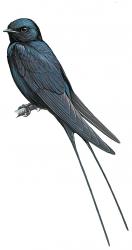Week 13 – 02 October 2016:
I Love Birds, But…
A child who wanted to create a picture of a Blue Swallow would only need one crayon – Midnight Blue. These birds are deep metallic colour all over, and sport a pair of very long tail feathers. Blue Swallows breed in southern Africa and spend the non-breeding season further north in Kenya and Uganda. Regrettably, very few children are likely to know what a Blue Swallow looks like. Just 3000 members of this species remain, and those are thinly distributed. There are more people living in Thermopolis, Wyoming, than there are Blue Swallows in all the world. I have been to Thermopolis. It isn’t big. Southern Africa is.
According to preliminary observations, it seemed that a substantial breeding population of Blue Swallows might reside in the southern Tanzanian highlands. Steven Evans and colleagues at the University of Venda, North-west University (both in South Africa), and the Tanzanian Bird Atlas Project recognized the pressing need to quantify the swallow’s abundance in the region. Ideally they would also be able to determine the bird’s habitat preferences, and current threats to that habitat.
Evans and his team conducted two surveys of Tanzania’s Kipengere Mountain Range; once in 2008/2009, and again in 2012. The team surveyed 3,635 km (2260 miles) of grasslands, pastures, croplands, villages, and tree and tea plantations. (For perspective, this is greater than the distance from Thermopolis, Wyoming, to Montreal, Quebec, or between Strasbourg in France and St. Petersburg in Russia.) For each swallow sighting, GPS coordinates, altitude and habitat type were recorded. The group found nests of Blue Swallows by searching the undersides of bridges and by asking locals.
The total of 151 Blue Swallows and 14 nests were recorded at 62 localities. Considering the total area searched, and by estimating the total area suitable for the species in that part of Tanzania, Evans and crew felt that the region was likely to support between 602 and 1362 individuals. Clearly, the southern Tanzanian highland grasslands support a significant proportion of the world’s population of Blue Swallows, particularly in natural pastures and around villages. “This finding indicates that the development of rural villages is not a threat to the birds,” wrote Evans et al. Indeed, Blue Swallows may be feeding on insects attracted to livestock and dung, and buildings in villages may provide a suitable surface for the construction of swallow nests. It is even possible that artificial structures could be erected to facilitate swallow nesting.
Evans and his coworkers described the need for similar swallow surveys in the Marungu Highlands and Upemba National Park in the DRC. If they are currently planning such work, then they must be braver than I. On its website: “Global Affairs Canada advises against non-essential travel to the Democratic Republic of Congo… points of entry from Burundi, Rwanda and Uganda should be avoided at all times because of continuing insecurity and lawlessness in those areas… Crime is endemic in the DRC as a result of extreme poverty and the prevailing climate of impunity.”
I love birds, but not enough to get killed while conducting a survey.
Evans, S. W., E. M. Baker, N. E. Baker and D. Cillers. 2016. Current distribution and population size of the Blue Swallow Hirundo atrocaerulea in the southern Tanzanian highlands. Ostrich 87:37-46.
Photo credits: male Blue Swallow, The Handbook of the Birds of the World Alive - http://www.hbw.com/species/montane-blue-swallow-hirundo-atrocaerulea; female Blue Swallow photograph by Warwick Tarboton (copyright Warwick Tarboton) – www.warwicktarboton.co.za/index.html



